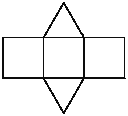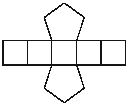On the Subject of Johnson Solids
If your Johnson solid for more than four hours you should see a doctor.
On the module is one polyhedron which is a member of the Johnson solids. To defuse the module, you must name it and input its corresponding number into the module.
The polyhedron may be hidden by pressing the J. Pressing the J again will cause the polyhedron to become visible again.
Finding Its Name
The Johnson solids fall into three main types: Pyramids, cupolae and rotundae, Modified uniform solids, and Elementary solids.
Pyramids, cupolae, and rotundae
Solids in this category are one of the eponymous pyramids, cupolae, or rotundae, or a modification of one or more of them.
All sections of a solid’s name should be ordered by appearance in this list:
- Elongated: having a ring of squares separating two halves.
- Gyroelongated: having a ring of alternating triangles separating two halves.
- Triangular: using a triangle.
- Square: using a square.
- Pentagonal: using a pentagon.
- Gyro-: having one half gyrated (twisted), indicated by their main polygon.
-
Ortho-: not having one half gyrated (twisted).
- Ortho- is only used when a cupola or rotunda is opposite another.
- Bi-: having two instances of.
- Pyramid: having a polygon surrounded by triangles which converge to a single point.
-
Cupola: having a polygon surrounded by alternating squares and triangles.
- The digonal cupola, also known as a triangular prism, is referred to as a fastigium.
-
Rotunda: having a polygon surrounded by triangles and pentagons.
- If both a cupola and a rotunda appear in the solid, both names are used.










